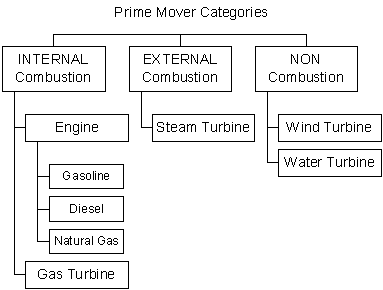|
We’re
going to organize the prime movers into the following categories:

-
Internal
Combustion
- An Internal Combustion Engine is one which
burns fuel within the engine itself (like a diesel engine or gas
turbine) rather than in an external furnace (like a boiler and
steam engine). Power is produced by the expansion of hot combustion
gases against one of the working surfaces of the engine, such
as the face of a piston, a turbine blade or a nozzle. Internal
Combustion Engines can be broken down into two main categories:
Continuous combustion
|
Intermittent combustion
|
- Steady flow of fuel
- Steady flow of oxidizer (i.e. air)
- Stable flame is maintained in the engine
|
- Discrete volumes of fuel are injected at specific intervals
- Discrete volumes of the oxidizer (i.e. air) are injected at specific intervals
- Ignition occurs at specific intervals in the cycle
|
|
Example: Jet Engine
|
Example: Gasoline piston engine or Diesel piston engine
|
- External
Combustion
- With an External Combustion Engine the
fuel is burned in a separate chamber. For example, a boiler can
burn heating oil and heat water to create steam. Then the steam
can be fed into a steam turbine, which converts the heat energy
into spinning energy.
-
- Non-Combustion
- These prime movers convert existing mechanical
energy directly into electricity.
Let’s take a look at one of the most common prime
mover – the reciprocating engine.
|